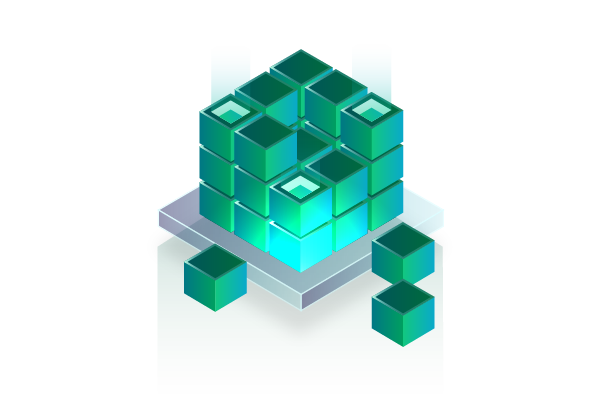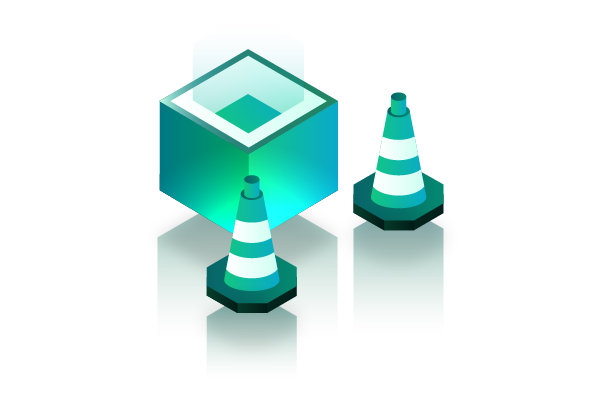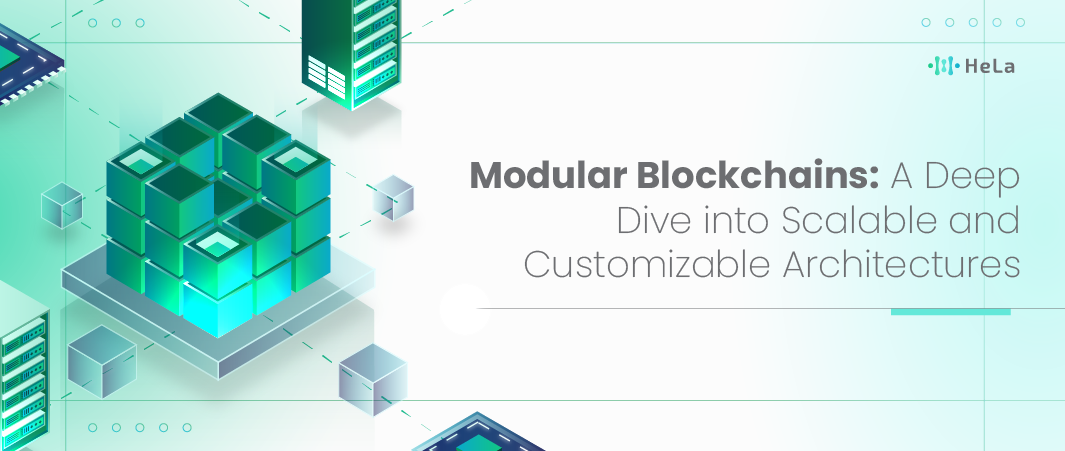In recent years, modular blockchains have emerged as a revolutionary approach to solving some of the most pressing limitations in blockchain technology, especially around scalability and efficiency. Traditional monolithic blockchains, which manage all processes like transaction execution, consensus, and data storage within a single system, often face bottlenecks, higher transaction costs, and limited adaptability. Modular blockchains break down these functions into separate, specialized layers, each responsible for a distinct aspect of the blockchain’s operation.
This architecture is transforming how developers and enterprises think about blockchain scalability, creating a highly adaptable and efficient system where components can be optimized or scaled independently. By doing so, modular blockchains open the door to high-performance applications in industries requiring rapid processing speeds, flexible architecture, and cost-effectiveness—all without sacrificing security. This layered approach to blockchain architecture could be the foundation for future Web3 developments, enabling a more robust, interconnected digital ecosystem where decentralized applications can flourish at a larger scale than ever before.
What is Modular Blockchain?

Modular blockchain is an innovative approach to blockchain architecture, breaking down the monolithic structure of traditional blockchains into specialized layers or modules. Unlike traditional blockchains, where consensus, data availability, execution, and settlement are tightly interwoven, modular blockchains isolate these functions into distinct, interoperable layers. This separation allows each module to optimize its specific role, enabling greater scalability, flexibility, and customizability across blockchain networks.
At the core, modular blockchains allow different layers to focus on a singular purpose: for example, one layer might handle data availability and consensus, while another focuses on transaction execution. A popular configuration is to use rollups (for scalable execution) on top of a layer like Ethereum (for secure settlement). By offloading execution to dedicated chains (often called “rollup” or “execution” layers) and using a base layer for security and finality, modular blockchains can process transactions faster and more cost-effectively than traditional monolithic chains.
Also read: 12 Best DeFi Lending Platforms to Check this 2024
Another key advantage of modular blockchains is their adaptability. By enabling interchangeable components, developers can tailor blockchain systems to meet specific demands. For instance, a blockchain network prioritizing security could reinforce its consensus module, while another focusing on speed could enhance its execution layer. This flexibility means that modular blockchains could form a foundation for a “Lego-like” ecosystem where developers assemble blockchain solutions based on unique requirements rather than being restricted to one-size-fits-all protocols.
Key Components of Modular Blockchains

Modular blockchains represent a novel approach to blockchain design by breaking down the traditional, all-in-one blockchain model into distinct, specialized components. Each of these components, or “modules,” performs a unique function within the blockchain ecosystem, enabling greater scalability, flexibility, and efficiency across networks. By separating tasks like consensus, data availability, execution, and settlement, modular blockchains allow for faster transaction speeds, reduced costs, and the ability to customize components to meet specific needs.
Here’s a breakdown of the key components that make up modular blockchains:
1. Consensus Layer
- The consensus layer is responsible for securing the network and ensuring agreement among nodes about the state of the blockchain.
- It verifies transactions and blocks, creating a trusted environment where all participants follow the same rules.
- This layer can operate independently, allowing other modules to focus on different tasks, such as executing transactions or managing data availability.
Key Benefits:
- Enhanced Security: Separating consensus helps reinforce the network’s integrity, as it can be optimized solely for security.
- Scalability: As consensus operates independently, it allows other layers to function without being slowed down by consensus overhead.
2. Data Availability Layer
- The data availability (DA) layer ensures that transaction data is readily accessible and verifiable by anyone who needs it.
- It works to make data public, transparent, and resistant to tampering, which is crucial for preventing fraud and promoting trust in the blockchain.
- The DA layer guarantees that data remains accessible without clogging up the blockchain itself, typically using sharding or off-chain storage.
Key Benefits:
- Reduced Storage Requirements: Only essential data remains on-chain, reducing blockchain bloat and improving network efficiency.
- Improved Transparency: Users and developers can access transaction data independently, increasing trust in the system.
3. Execution Layer
- The execution layer is where smart contracts and transactions are processed and executed.
- It handles computation-intensive tasks separately from the main chain, reducing congestion and keeping fees low.
- This layer often utilizes rollup solutions, which process transactions off-chain before settling them on-chain, providing both speed and cost-effectiveness.
Key Benefits:
- Scalability and Efficiency: Processing transactions off-chain reduces the load on the main blockchain, allowing for faster, cheaper transactions.
- Customization: Developers can create custom execution environments optimized for specific applications, such as DeFi or gaming.
4. Settlement Layer
- The settlement layer records and finalizes transaction results to create a secure, tamper-proof ledger.
- It provides an authoritative record of transaction history and ensures that the final state is accepted by all participants.
- Settlement layers often reside on secure, established networks (e.g., Ethereum), adding a high level of reliability and decentralization.
Key Benefits:
- Security and Reliability: The settlement layer acts as the final checkpoint, ensuring transactions are irreversible and secure.
- Interoperability: By standardizing how transactions are finalized, this layer enables easier integration with other blockchains and applications.
5. Interoperability Layer
- While not always considered a core layer, interoperability plays a crucial role in allowing different blockchains and modules to communicate.
- This layer enables cross-chain transactions and asset transfers, fostering a more connected and flexible blockchain ecosystem.
- By providing a framework for interoperability, modular blockchains can interact seamlessly with other blockchains and decentralized applications (dApps).
Key Benefits:
- Cross-Chain Collaboration: Enables blockchains to share data, assets, and smart contracts across networks.
- Enhanced Ecosystem Flexibility: Encourages a broader, more interconnected blockchain ecosystem where specialized chains can coexist and cooperate.
Summary of Key Benefits of Modular Blockchains
Modular blockchains provide several overarching advantages:
- Scalability: By offloading tasks to specialized layers, modular blockchains can handle more transactions per second, reducing congestion and lowering fees.
- Flexibility and Customization: Developers can design and optimize each module according to their unique requirements, enabling tailored blockchain solutions.
- Security: With separate layers dedicated to consensus and settlement, modular blockchains create a robust security framework.
- Interoperability: By enabling communication between chains, modular blockchains promote an interconnected and decentralized ecosystem.
Real-World Applications of Modular Blockchain

The flexibility and scalability of modular blockchains make them ideal for various industries and applications, especially those requiring high transaction volumes or complex data management.
1. Decentralized Finance (DeFi)
- DeFi applications require high throughput, low fees, and strong security to support activities like lending, borrowing, and trading.
- Modular blockchains allow DeFi applications to handle transaction execution off-chain, resulting in faster and cheaper transactions that settle securely on a main chain.
2. Gaming and NFTs
- Games and NFTs often require frequent, low-cost transactions to handle in-game assets, item trades, and collectibles.
- Execution layers tailored for gaming can reduce congestion, while settlement layers ensure that digital assets are secure and tamper-proof.
Also read: Crypto Arbitrage: Types, Strategies, and Advantages in Crypto Trading
3. Supply Chain and Logistics
- Supply chains benefit from transparent data availability and verification, as they involve multiple parties and require consistent tracking of assets.
- A modular blockchain with a strong data availability layer could ensure that supply chain data is accessible, secure, and easily verifiable across all participants.
4. Data-Heavy Applications
- Applications that generate large amounts of data, such as healthcare or IoT systems, require efficient data storage and access without compromising security.
- Modular blockchains enable such applications to offload data management to dedicated layers, ensuring data availability and accessibility without overloading the main chain.
7 Best Modular Blockchain Coins to know in 2024

The rise of modular blockchains has transformed the blockchain landscape by offering solutions that overcome the scalability, efficiency, and interoperability limitations of traditional monolithic blockchains. Modular blockchain coins are at the forefront of this innovation, enabling flexible, scalable ecosystems where different layers handle specialized functions. Here’s a look at seven of the best modular blockchain coins, each driving significant advancements in decentralized technology.
1. HeLa (HLUSD)
HeLa (HLUSD) is a new modular blockchain coin developed for applications that require high-speed, low-cost transactions and a unique focus on data availability and security. Built with scalability in mind, HeLa’s architecture separates consensus and execution layers, ensuring optimized performance for various applications, especially in financial services and cross-border transactions.
- Modular Role: HeLa separates transaction execution from data availability, enabling efficient, high-speed transactions.
- Use Case: HLUSD can be used across decentralized applications, especially those focused on financial transactions and data-heavy applications.
- Advantages: Low transaction fees, high data availability, optimized for financial applications and real-time processing.
With its emphasis on data availability and low-cost transactions, HeLa (HLUSD) has the potential to become a core component for decentralized financial systems and cross-border payment solutions.
2. Ethereum (ETH)
As Ethereum transitions into Ethereum 2.0, it’s evolving into a modular blockchain, with sharding and rollups improving scalability and data availability. This transition allows Ethereum to maintain its place as a leading platform for dApps, DeFi, and NFTs.
- Modular Role: Ethereum 2.0’s sharding structure and Layer-2 rollups support scalability by handling execution and data availability separately.
- Use Case: ETH is used for gas fees, staking, and network governance, powering an extensive ecosystem of decentralized applications.
- Advantages: Massive developer ecosystem, high security, adaptability through Layer-2 solutions.
Ethereum’s modular approach enables high performance and increased scalability, ensuring it remains a top choice for developers and enterprises building decentralized applications.
3. Celestia (TIA)
Celestia is a modular blockchain designed specifically to handle data availability and consensus, allowing other blockchains to build on top of it for execution. This unique focus on data availability makes Celestia ideal for Layer-2 scaling and cross-chain compatibility.
- Modular Role: Celestia’s main function is to provide data availability and consensus, leaving execution to Layer-2 networks.
- Use Case: TIA tokens are used for staking and transaction fees within the Celestia network.
- Advantages: Optimized scalability, high interoperability, minimal transaction costs.
Celestia’s specialization in data availability makes it a cornerstone for other modular chains and dApps that require reliable data access and efficient consensus.
4. Polkadot (DOT)
Polkadot’s architecture centers on its Relay Chain, which provides security and consensus, while independent parachains handle execution for specific use cases. DOT, the native token, is essential for staking and governance in this ecosystem.
- Modular Role: The Relay Chain provides consensus, with customizable parachains handling execution.
- Use Case: DOT is used for staking, parachain bonding, and governance within the Polkadot ecosystem.
- Advantages: High interoperability, customizability, decentralized governance.
DOT allows developers to create purpose-built blockchains that can seamlessly interact, enabling Polkadot to support a wide array of applications.
5. Cosmos (ATOM)
Cosmos is a modular blockchain that focuses on interoperability through its Inter-Blockchain Communication (IBC) protocol, allowing different blockchains to communicate. ATOM, the native token, plays a role in staking, governance, and as a utility for the Cosmos Hub.
- Modular Role: Cosmos Hub provides consensus and interoperability, while independent zones handle execution and custom applications.
- Use Case: ATOM is used for staking, governance, and transaction fees in the Cosmos network.
- Advantages: High interoperability, customizable blockchain zones, efficient consensus.
Cosmos and ATOM drive an interconnected ecosystem, where assets and data can move across chains, making it ideal for cross-chain applications.
6. Avalanche (AVAX)
Avalanche uses a modular blockchain model with its three-chain structure: the X-Chain for asset transfer, the C-Chain for smart contracts, and the P-Chain for staking and validator coordination. This division optimizes Avalanche’s network for high transaction speeds and diverse applications.
- Modular Role: Avalanche’s modular structure allows each chain to focus on specific functions, enhancing scalability and flexibility.
- Use Case: AVAX is used for staking, transaction fees, and governance.
- Advantages: High throughput, low latency, customizable subnet structure.
AVAX supports fast and efficient transactions across decentralized applications, making Avalanche a powerful choice for developers needing performance at scale.
7. Near Protocol (NEAR)
Near Protocol is a high-performance, modular blockchain known for its sharding architecture, which allows it to handle large transaction volumes with low fees. Through its unique “Nightshade” sharding technology, Near can efficiently process transactions, making it ideal for developers and projects requiring scalable infrastructure.
- Modular Role: Near Protocol uses sharding to divide its blockchain into smaller, manageable segments that process transactions in parallel, optimizing for scalability and efficiency.
- Use Case: NEAR tokens are used for staking, transaction fees, and governance within the protocol.
- Advantages: Developer-friendly, scalable architecture, low transaction fees, and high-speed processing.
Near Protocol’s modular structure allows it to support a wide array of decentralized applications (dApps), making it a strong competitor in the modular blockchain ecosystem. Its sharding approach ensures both scalability and decentralization, which are crucial for high-demand applications in DeFi, gaming, and beyond.
Why Modular Blockchain Coins Are Important
These modular blockchain coins—HLUSD, ETH, TIA, DOT, ATOM, AVAX, and NEAR—each play a crucial role in advancing the capabilities of blockchain networks. By segmenting functionality across layers, modular blockchains achieve significant improvements in scalability, interoperability, and customization, addressing the challenges faced by traditional blockchains.
Benefits of Modular Blockchain Coins:
- Scalability: By separating layers, modular blockchains increase transaction throughput without compromising security.
- Interoperability: Many modular coins allow seamless cross-chain transactions, enabling assets and data to flow across ecosystems.
- Customizability: Modular architecture allows developers to build blockchains tailored to specific applications, enhancing flexibility.
- Efficiency: Modular blockchains can operate with lower fees by distributing transaction processing, reducing costs for users and developers.
Conclusion
In conclusion, modular blockchains are more than just an architectural improvement; they represent a transformative shift in the way we envision and build decentralized systems. This multi-layered structure not only enables blockchain to scale effectively but also unlocks a new level of adaptability that challenges the one-size-fits-all approach of traditional chains. By isolating functions into layers like consensus, data availability, execution, and settlement, modular blockchains break free from the rigid frameworks that have limited blockchain’s potential, offering a future where each layer can be tailored, upgraded, and innovated upon independently.
This separation of concerns allows blockchain networks to evolve alongside Web3 demands, welcoming diverse use cases that were previously impractical. Imagine an ecosystem where DeFi applications, gaming, supply chains, and even national digital currencies can each optimize their layers for specific needs, all while sharing a secure and interoperable settlement foundation. Modular blockchains essentially bring a “Lego-like” flexibility to blockchain design—developers can assemble custom solutions with the freedom to prioritize speed, security, or cost-efficiency as needed, without sacrificing network integrity.
Disclaimer: The information provided by HeLa Labs in this article is intended for general informational purposes and does not reflect the company’s opinion. It is not intended as investment advice or recommendations. Readers are strongly advised to conduct their own thorough research and consult with a qualified financial advisor before making any financial decisions.

Robert Mbogni
I am a technical writer and versatile technology professional with more than nine years of experience across engineering, software development, and IT operations. I was born in Cameroon and have built my career through a combination of academic achievement, hands-on industry work, and a deep commitment to continuous learning. I hold a postgraduate degree as a Mobile Application and Server Tester, along with a degree in Electrical Engineering, which has shaped the foundation of my analytical and problem-solving mindset.
Throughout my professional journey, I have contributed in a variety of roles, including Senior Process Executive, Technical Content Writer, Senior Software Engineer, IT Technical Support, Sales Engineer, and Data Engineer. This diverse background has allowed me to approach technology from multiple perspectives—technical, operational, and business-driven.
My skill set spans a wide range of programming languages, tools, and platforms, including Java, Python, C++, VBA, SQL query, and Power BI, as well as systems such as Windows, Linux, ERP, CRM, and analytics platforms like Google Analytics. I also have hands-on expertise with development and workflow tools including GitHub, Zoro Odoo, Vtiger, and Bitrix. This broad technical knowledge enables me to understand complex systems and communicate them clearly to both technical and non-technical audiences.
- Robert Mbogni#molongui-disabled-link
- Robert Mbogni#molongui-disabled-link
- Robert Mbogni#molongui-disabled-link
- Robert Mbogni#molongui-disabled-link

